Review: The Surplus of Postdocs

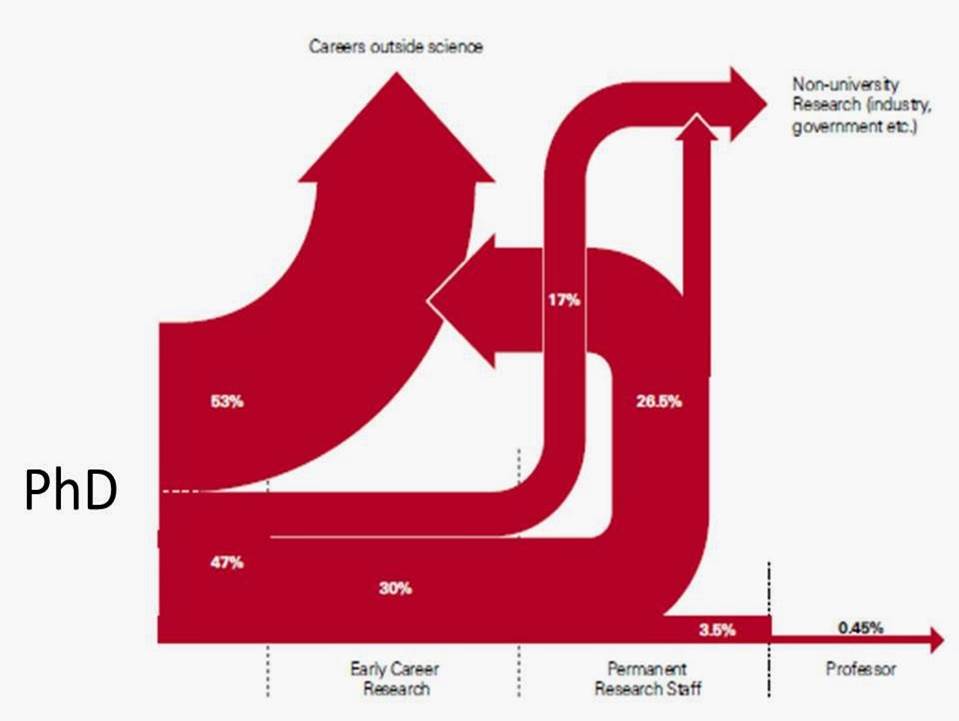
Source: “The Scientific Century: Securing our Future Prosperity”, Royal Society Policy document, 2010.
An alarming number of postdocs are facing trouble in finding stable positions in academia and industry. Although this problem isn’t something new and has been going on already for several decades now, its current state is a real concern among researchers, with no solutions in sight in the short term. In this article we will try to summarize what has been said about the postdoc problem, the proposals to restructure academy, the situation across different countries and the alternatives to research.
The origin of the postdoc problem
Postdoctoral scholars are individuals who hold a PhD and are performing research mentored by a senior researcher. The “postdoc” is supposed to be a career step between the PhD and a permanent position -as principal investigators (PIs) with their own research group, as associate researchers or in research posts outside of academia. Postdoctoral scholars are highly skilled and are the most productive members of the research landscape, due to a number of factors: expertise, energy and the motivation and pressure to publish.
The number of postdoctoral researchers increased steadily in the US between the ’60s and the ’90s. According to some reports, many postdocs acknowledged to be using the position not primarily for training but as a “low-pay” job while waiting for a permanent slot. However, a study conducted by the National Science Foundation in 1998 concluded that the rise in postdocs was too steady to be due to labor market conditions. In any case, a first version of the postdoc problem was already brewing. At the beggining of the 21st century, a report alerted about the “brain drain”: the brightest students were increasingly avoiding research careers due to the long training and poor future prospects. This trend, especially acute in mathematics and engineering during the ’90s , had the notable exception of biology, perhaps due to its attractiveness among students. The authors recommended to revert the tendency by increasing the number of research assistant professor positions, who would later compete for a tenured place.
Spurred by a growing economy, the US government decided to boost biomedical research. The current structure of the academic system took form then, when research (especially biomedical) was expanding. Between 1998 and 2003, the NIH budget increased spectacularly each year, doubling the funding in 5 years. Infrastructures were built and many programs -especially in applied and translational research- were well financed.
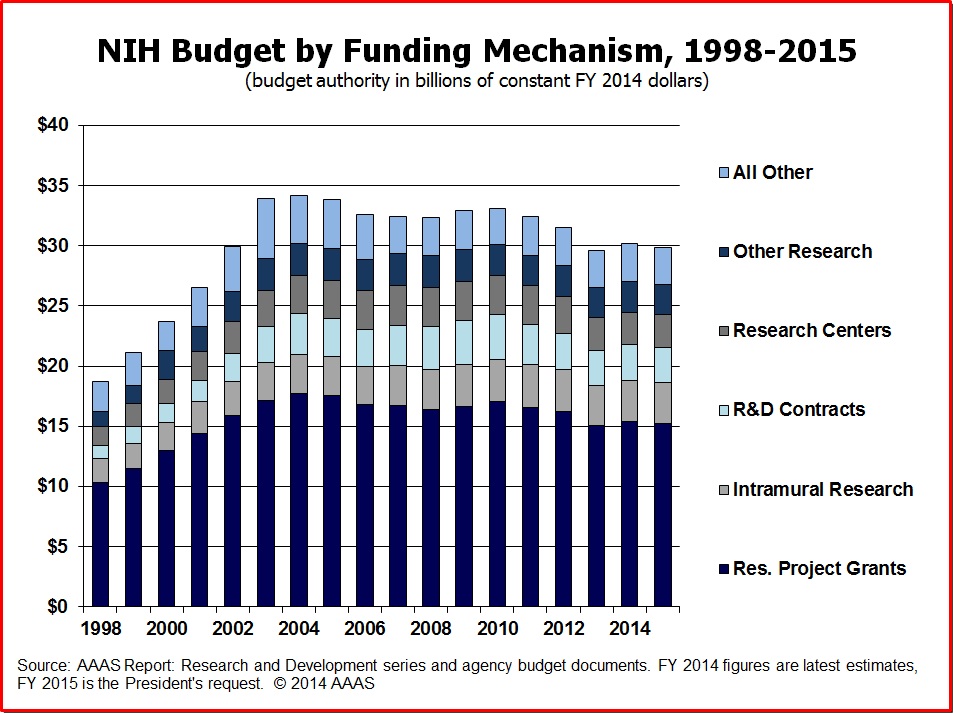
Thanks to the global expansion of higher education, the number of science doctorates increased in 40% between 1998 and 2008 in OECD countries, and the trend continued with correlations seen between skilled scientists and economic progress. In the US, PhDs increased by 150% between 2000 and 2012.
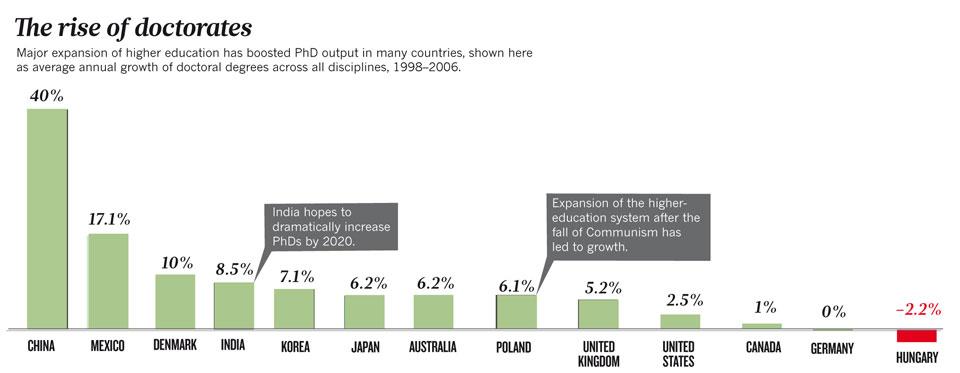
Source: http://www.nature.com/news/2011/110420/full/472276a.html
The NIH had planned a gradual slowdown in funding after the 5 year budget doubling. However, expanded military spending and severe tax cuts modified that plan. In most OECD countries, research spending was affected by the financial crisis of 2007-08. The OECD’s share in global R&D spending slipped from 90% to 70% in a decade.
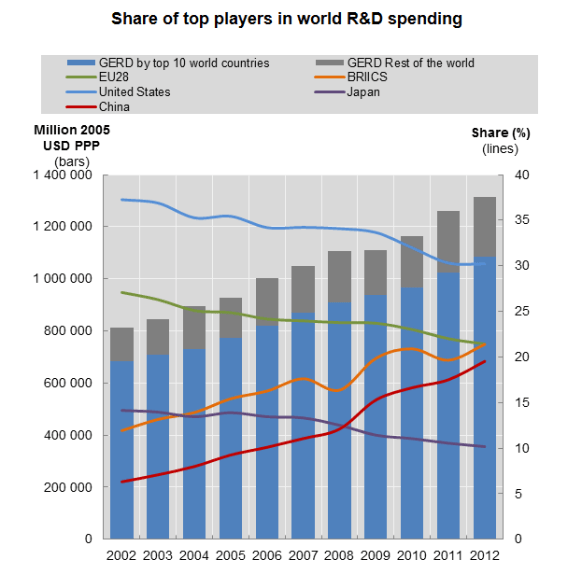
Source: OECD (http://www.oecd.org/newsroom/china-headed-to-overtake-eu-us-in-science-technology-spending.htm).
In Europe, tendencies were different between North and South. While Germany has even increased the expenditure in R&D since 2007, countries like Spain have experienced a dramatic cut in funding.
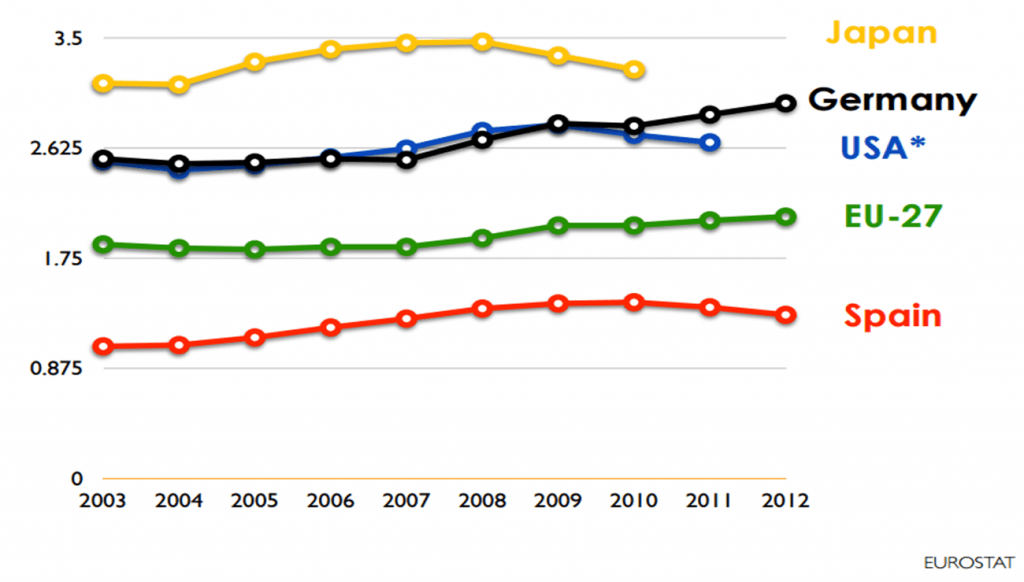
Source: Eurostat, investigaciondigna.es.
The current situation of postdocs across the globe
In the 90’s Japan decided to expand the number of postdocs by recruiting more PhD students. The plan ended up badly: no strategy was conceived for the time when the graduate students would become postdocs. They are not needed in academia, but Japanese companies don’t hire them either as they prefer to train fresh bachelors.
The number of Chinese new doctoral graduates every year probably surpasses the rest of the world’s new PhD holders combined. Although many PhDs are not up to par with international standards, they can easily find a position in the country. Measures are being implemented to ensure all universities are at international level.
The city-state of Singapore has seen an increase in R&D investment in the last years, and new public universities have been built. Consequently, postdocs will soon find more positions in academia. Currently, most work in other sectors, but enjoy good salaries.
After many years producing more PhDs than any other European country, Germany is redesigning its academic system to avoid the postdoc oversupply problem. Less than 6% of PhD holders end up in academic positions, so universities train them in transferable skills. Most find research jobs in the powerful industry sector.
After the fall of communism, Poland increased the recruitment of PhD candidates. However, lack of funding causes more than 50% of the students to drop out of PhD programs. Although unemployment is lower for PhD holders, they are not more satisfied with their job than the rest of workers.
Egypt enrolls more doctoral students than any other Middle Eastern country, but their options are scarce. Research funding is limited, universities can’t absorb them, and industry complains about their lack of practical skills.
Thanks to their country’s economic boom, the Indian government was able to invest massively in higher education and increase the number of PhDs. However, few students currently choose a career in research since government stipends and grants are barely sufficiently to manage oneself let alone a family. Most prefer pursuing post docs in Europe and America. This has led to brain drain from the country. A bachelor can easily find well paying IT jobs, and industry is more lucrative and secure than academia.
Italy, Spain, Greece and Portugal were particularly hit by the 2007-08 financial crisis, and research funding took a hard blow. Since 2009, Italy has suffered a 90% cut in recruitment, a 100% cut in basic research grants and the disappearance of 40% of doctoral courses. In the same time span, Spain has witnessed a 40% cut in basic research grants, the disappearance of 90% of the permanent positions left open due to retirement and the systematic breach of tenure track contracts. Since 2011, Greece has been subject to a 50% cut in funding of research centres and universities and a 100% cut in new hiring. In Portugal, 50% of the country’s research units might be facing closure. In general, it is extremely unlikely for a postdoc to find an academic position in Southern Europe. The industrial sector is not as developed as in the North, and companies rarely appreciate the differential qualities in postdocs.
In most Latin American countries there is a limited budget for research, resulting in a lack of properly trained research staff and public or private research infrastructures. As a consequence, they are usually not considered a destination by postdocs, with the possible exceptions of Chile and Brazil. Since 2008, Chile has invested many resources to train PhDs. Many of them went abroad to complete a postdoc, funded by the Chilean government, and now it is unclear whether the country will have the capacity to absorb them. Brazil implemented a plan to increase the number of scholarships and fellowships for undergraduates, master’s and PhD students, postdoctoral students and senior researchers from 102000 in 2007 to 170000 by 2011.
Since 2012, workers in France must be appointed to a permanent position after six years of short-term contracts in the public sector. Due to the lack of available permanent positions, public research institutions are not renewing postdoctoral contracts after the first appointment (usually three years), forcing researchers to go abroad, thereby leading to brain drain.
In 2010, the New Zealand government terminated a postdoctoral funding scheme, eliminating one-third of its postdocs. This measure was not part of any plan to deal with the postdoc crisis: it was done to save money. Outside of academia, researchers find very few jobs in their area of expertise. Laboratories have seen a decline in productivity, and some of the best researchers go abroad.
In the United States, after years of rapid growth (1998-2003), federal funding reached a plateau and eventually shrinked. The current situation is the result of a diabolical combination: too many postdoctoral researchers and too little money to support a research that is increasingly expensive. The number of tenured and faculty positions has frozen while the number of PhDs continues to increase, especially in the biomedical sciences. 65% of PhD holders go into a postdoc; from those, only 15-20% get a tenure-track academic position.
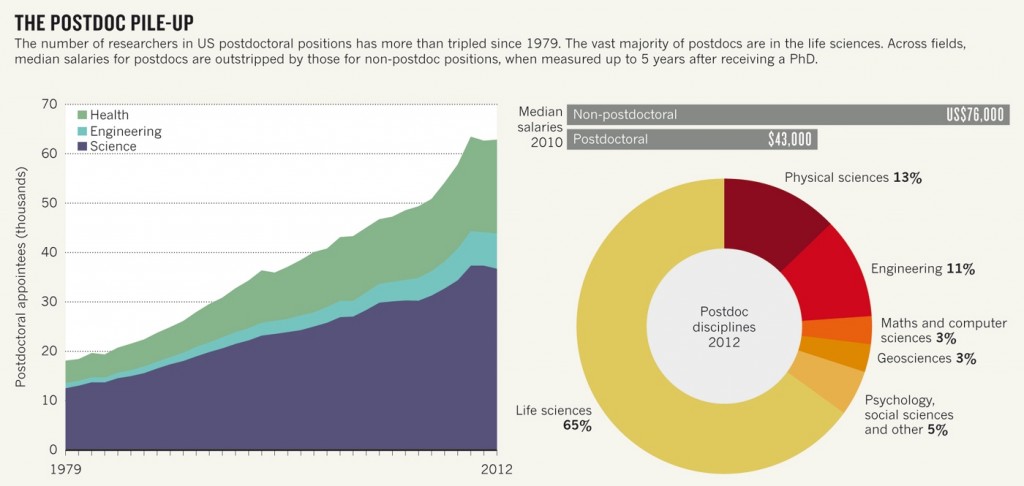
Source: http://www.nature.com/news/the-future-of-the-postdoc-1.17253?WT.ec_id=NATURE-20150409
PIs have all the incentives to hire postdocs, who are cheaper than permanent researchers and even graduate students (considering stipends and tuition costs). Most labs rely on them to produce results and secure research grants that guarantee the future of the lab itself. This is not a minor detail: it means that the people on top of the pyramid, even if they care about their postdocs, are not willing to change the system. The current model promotes the existence of oversized labs, where PIs can’t dedicate time to mentor their postdocs and prepare them to become independent researchers. Any training is a byproduct of work.
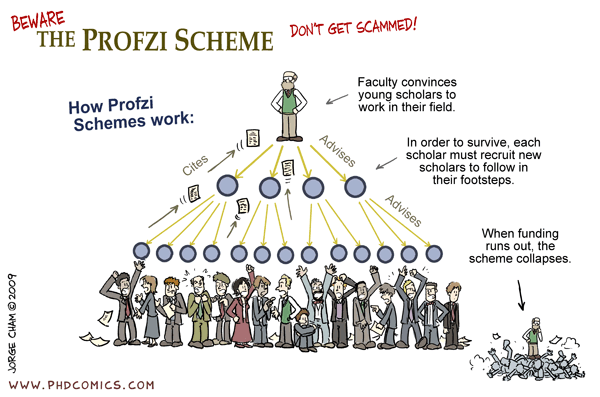
Another detrimental consequence of having a large pool of qualified people and a lack of funding is a hypercompetitive environment where few risks are taken. Creative thinking is restricted, and researchers stick to ideas that will most probably work and be publishable in a relatively short period of time.
The Rise of “PermaDocs”
Due to the lack of available positions, most postdocs become “permadocs”, expanding their postdoctoral phase for years. As a result, the number young researchers leading a laboratory has decreased.

Source: http://www.pnas.org/content/112/7/1912.full
Most postdocs end up experiencing occupational burnout. It may take just one postdoc or switching between various labs but, eventually, the added experience of unsuccessful grant applications, absent (or, on the contrary, over-controlling) PIs, poor economic reward, perpetual mobility, scarce career prospects and other factors end up convincing them that it’s time to go away.
Alternative careers
But outside of the ivory tower things don’t look promising either. The private sector is unable to absorb the surplus of researchers, and many academic profiles (e.g. basic researchers) are seen as ill-suited for the industrial environment. Postdoctoral training is, in many cases, a huge waste of time and money, for the postdoc and for society as a whole. Despite their ability, they end up as demotivated and disgruntled workers at posts for which they are over-qualified and where they are unable to exploit their potential.
There are science-related careers in publishing, grants administration and public engagement, but these rarely need postdoctoral experience. Mature postdocs feel they have lost precious years, and struggle with career change. Besides, compared a bachelor’s degree graduate of their age, they earn 40% less per hour.
How to fix the broken scientific career?
Several solutions have been proposed to change the current academic structure. The fixed-term postdoc would limit the total postdoctoral time -adding all postdoctoral experiences- to five years, forcing postdocs to take decisions before running into problems like their advisor’s retirement. Also, it would compel them to face their real chances in academia and build up alternative pathways before it’s too late for a change. Some countries have enforced this policy with mixed results; legal loopholes allow to continue in academia with short-term contracts.
Some academics think that a postdoc should be hard to get: the number of postdoctoral positions should be reduced and belong just to an elite of top PhD holders. Implementing this option would harm many labs that currently depend on a large number of postdocs for lab management, student mentoring and grant writing. Some PIs are against this measure: they claim that it would reduce the dynamism and productivity of their labs. Besides, the brightest researchers are often not discovered until they are well into their postdoc.
The most popular measure among postdocs would be the creation of senior staff scientist positions. Postdocs who do not wish or can’t find a position as PIs would be permanently integrated into a research group, with a better pay. These posts already exist in some institutions and have proven to be very beneficial for the labs. They are often specialists in some discipline -bioinformatics, microscopy-, train students and help writing grants. However, without a budget increase, these posts come at the price of fewer people in the lab, and thus a decrease in overall productivity.
A report by the National Academies suggests that the solution lies in reestructuring the lab, making it smaller, with less students and postdocs and more permanent staff. Although most PIs are reluctant to the idea, some recognize that their labs would be equally productive with one experience researcher replacing three students.
Some postdocs propose a series of initiatives. Research institutions should warn students that, except for a small percentage of researchers, a postdoc will not get them a job in academia nor advance their career; time and lab management skills should be taught; selection processes should be more stringent to ensure only the brightest candidates enroll; students should take surveys to determine if they are better suited for industry or academia; and independent, permanent staff positions -not attached to a PI’s grant- should be created. Similar proposals include moving graduate students and postdocs from research grants to training grants, increasing postdoc salaries and expanding an already existing grant programme, Best, designed to modernise training and prepare students for a wide range of careers. The goal is to move the decision point from the end of the postdoc(s) to the end of the PhD.
Whatever the solution, the current cohort of postdoctoral students will suffer. We must urge the authorities to change this broken system so that future scientists enjoy a career that should be valued and respected: the progress of our societies depends on them.
